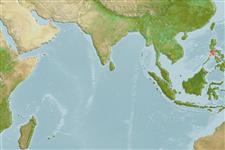>
Ovalentaria/misc (Various families in series Ovalentaria) >
Pseudochromidae (Dottybacks) > Pseudochrominae
Etymology: Pseudochromis: Greek, pseudes = false + Greek, chromis = a fish, perhaps a perch (Ref. 45335); fuligifinis: The specific epithet fuligifinis is a combination of the Latin fuligo, meaning soot, and the Latin finis, meaning end. It refers to the sooty appearance of the distal ends of the caudal-fin rays. To be considered a
noun in apposition (Ref. 88961).
More on authors: Gill & Williams.
Environment: milieu / climate zone / distribuzione batimetrica / distribution range
Ecologia
marino associati a barriera corallina; distribuzione batimetrica 5 - 33 m (Ref. 88961). Tropical; 14°N - 12°N, 120°E - 122°E
Indo-Pacific. Philippines. Known only from Verde Island, west coast of Mindoro and Apo Reef in the Philippines. It was collected from coral reef slopes and dropoffs at depths as deep as 33 m (Ref. 88961).
Size / Peso / Age
Maturità: Lm ? range ? - ? cm
Max length : 3.2 cm SL maschio/sesso non determinato; (Ref. 88961)
Short description
Chiavi di identificazione | Morfologia | Morfometria
Spine dorsali (totale) : 3; Raggi dorsali molli (totale) : 25 - 26; Spine anali: 3; Raggi anali molli: 14 - 15. Pseudochromis fuligifinis is distinguished from congeners by the following combination of characters: dorsal-fin rays III,25–26, with last 2–9 rays unbranched; anal-fin rays III,14–15 (usually III,15); circumpeduncular scales 16; dorsal-fin origin to pelvic-fin origin 23.4–25.9 % SL; horizontal scale rows below anterior lateral line 11–13; and caudal fin with sub-basal dark grey to black half-moon shaped marking on the caudal fin, with distal portion of fin posterior to dark spot and to distal tips of elongated dorsal and ventral lobes of fin sooty black (Ref. 88961).
Body shape (shape guide): elongated; Cross section: compressed.
Found in coral reef slopes and dropoffs to 33 m (Ref 90102).
Life cycle and mating behavior
Maturità | Riproduzione | Deposizione | Uova | Fecundity | Larve
Gill, A.C. and J.T. Williams, 2011. Description of two new species of Pseudochrominae from northern Palawan and Mindoro, Philippine Islands (Teleostei: Perciformes: Pseudochromidae). Zootaxa 3140:49-59. (Ref. 88961)
IUCN Red List Status (Ref. 130435: Version 2025-1)
Threat to humans
Harmless
Human uses
Strumenti
Special reports
Download XML
Fonti Internet
Estimates based on models
Preferred temperature (Fonte Biblio.
123201): 27.4 - 28.6, mean 28 °C (based on 2 cells).
Phylogenetic diversity index (Fonte Biblio.
82804): PD
50 = 0.5000 [Uniqueness, from 0.5 = low to 2.0 = high].
Bayesian length-weight: a=0.00501 (0.00193 - 0.01299), b=3.10 (2.88 - 3.32), in cm total length, based on LWR estimates for this (Sub)family-body shape (Ref.
93245).
Trophic level (Fonte Biblio.
69278): 3.2 ±0.5 se; based on size and trophs of closest relatives
Fishing Vulnerability (Ref.
59153): Low vulnerability (10 of 100).
🛈
